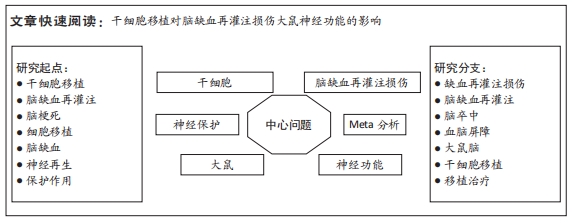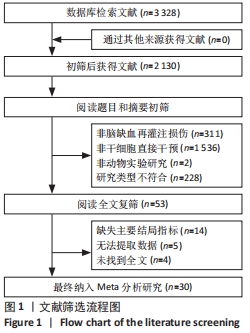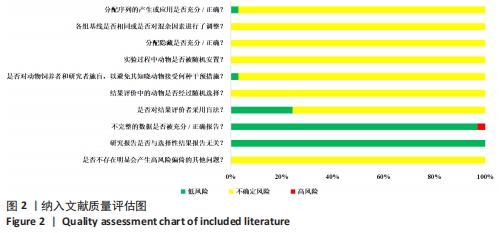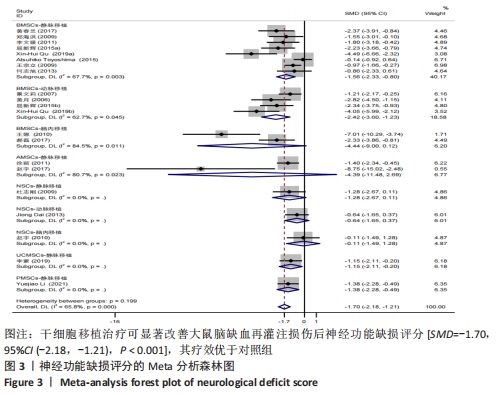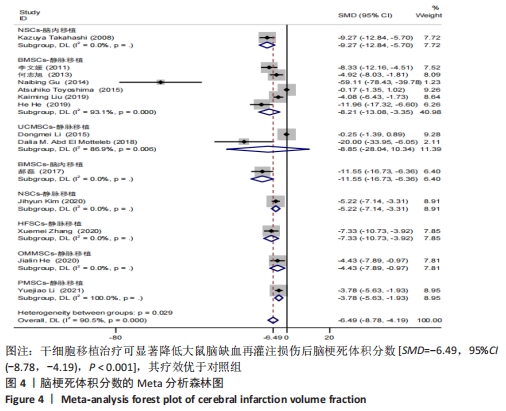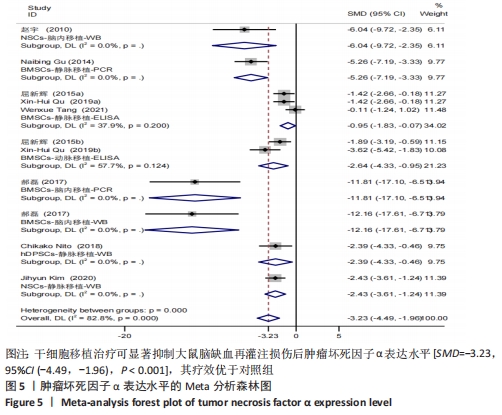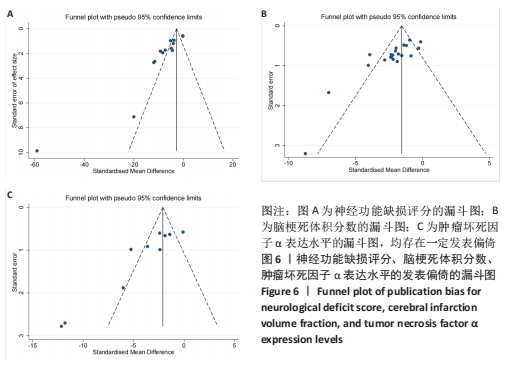[1] HUANG Z, GUO L, HUANG L, et al. Baicalin-loaded macrophage-derived exosomes ameliorate ischemic brain injury via the antioxidative pathway. Mater Sci Eng C Mater Biol Appl. 2021;126:112123.
[2] BARZEGAR M, KAUR G, GAVINS FNE, et al. Potential therapeutic roles of stem cells in ischemia-reperfusion injury. Stem Cell Res. 2019;37:101421.
[3] 王晓平,倪京满.脑缺血再灌注损伤的研究及药物治疗进展[J].中国新药杂志, 2016,25(6):659-663,691.
[4] 郝磊,刘磊,董岸莺,等.大鼠缺血再灌注损伤脑内骨髓间充质干细胞移植抑制TNF-α表达的上调促进TGFβ1表达的上调[J].中国组织化学与细胞化学杂志, 2017,26(4):327-335.
[5] 赵宇,谢鹏,朱晓峰,等.神经干细胞移植抑制缺血再灌注大鼠脑内星形胶质细胞的激活和炎症反应[J].第二军医大学学报,2010,31(6):678-681.
[6] 李蒙,李传文,孙俊启,等.人脐血间充质干细胞移植对脑缺血再灌注大鼠SIRT1-P53通路的影响[J].安徽医科大学学报,2019,54(4):534-538.
[7] HE H, ZENG Q, HUANG G, et al. Bone marrow mesenchymal stem cell transplantation exerts neuroprotective effects following cerebral ischemia/reperfusion injury by inhibiting autophagy via the PI3K/Akt pathway. Brain Res. 2019; 1707:124-132.
[8] BONCORAGLIO GB, RANIERI M, BERSANO A, et al. Stem cell transplantation for ischemic stroke. Cochrane Database Syst Rev. 2019; 5(5):CD007231.
[9] HOOIJMANS CR, INTHOUT J, RITSKES-HOITINGA M, et al. Meta-analyses of animal studies: an introduction of a valuable instrument to further improve healthcare. ILAR J. 2014;55(3):418-426.
[10] 黄月,许予明,宋波,等.骨髓间充质干细胞移植对缺血再灌注大鼠脑神经细胞凋亡及Bcl-2、Bax蛋白表达的影响[J].郑州大学学报(医学版),2006,41(5):862-864.
[11] 景文莉,闫凤霞. 经颈动脉移植骨髓间充质干细胞治疗局灶性大鼠脑缺血损伤[J].中国组织工程研究与临床康复,2007, 11(24):4747-4751.
[12] TAKAHASHI K, YASUHARA T, SHINGO T, et al. Embryonic neural stem cells transplanted in middle cerebral artery occlusion model of rats demonstrated potent therapeutic effects, compared to adult neural stem cells. Brain Res. 2008;1234:172-182.
[13] 王宗立,范红杰,庞超健,等.骨髓间充质干细胞移植对缺血再灌注大鼠脑神经细胞凋亡及survivin、caspase-3蛋白表达的影响[J].中国医科大学学报,2009, 38(11):834-837.
[14] 杜志刚,伊红丽,王艳玲,等.人脂肪神经干细胞移植对大鼠脑缺血后血管新生和细胞因子的作用[J].中国组织工程研究与临床康复,2009,13(10):1823-1828.
[15] 郑海洪,冯念苹,梁松岚,等.骨髓间质干细胞移植对大鼠脑缺血再灌注凋亡蛋白Caspase-3的影响[J].中国比较医学杂志,2009,19(4):27-30,51,封3.
[16] 王娜.骨髓间充质干细胞移植及生长相关蛋白43表达在脑修复中的作用[J].中国组织工程研究与临床康复,2010,14(40): 7474-7478.
[17] 李文嫒,王莹,孙平,等.骨髓间充质干细胞移植对大鼠脑缺血再灌注损伤Livin和Caspase-3表达的影响[J].中国组织化学与细胞化学杂志,2011,20(6):554-558.
[18] 徐颖,凌伟华,陆士奇,等.尾静脉移植羊膜间充质干细胞治疗大鼠脑缺血再灌注损伤[J].中国组织工程研究与临床康复,2011,15(49):9198-9201.
[19] DAI J, LI SQ, QIU YM, et al. Migration of neural stem cells to ischemic brain regions in ischemic stroke in rats. Neurosci Lett. 2013;552:124-128.
[20] 何志旭,严虎,刘俊峰,等.骨髓间充质干细胞移植治疗缺血再灌注脑损伤[J].中华实用儿科临床杂志,2013,28(6):435-439.
[21] GU N, RAO C, TIAN Y, et al. Anti-inflammatory and antiapoptotic effects of mesenchymal stem cells transplantation in rat brain with cerebral ischemia. J Stroke Cerebrovasc Dis. 2014;23(10):2598-2606.
[22] LI D, ZHANG M, ZHANG Q, et al. Functional recovery after acute intravenous administration of human umbilical cord mesenchymal stem cells in rats with cerebral ischemia-reperfusion injury. Intractable Rare Dis Res. 2015;4(2):98-104.
[23] TOYOSHIMA A, YASUHARA T, KAMEDA M, et al. Intra-Arterial Transplantation of Allogeneic Mesenchymal Stem Cells Mounts Neuroprotective Effects in a Transient Ischemic Stroke Model in Rats: Analyses of Therapeutic Time Window and Its Mechanisms. PLoS One. 2015;10(6): e0127302.
[24] 屈新辉,王万松,吴凌峰,等.动、静脉移植骨髓间充质干细胞治疗急性期缺血再灌注大鼠模型的比较[J].中国老年学杂志,2015,35(24):6965-6969.
[25] 黄春兰,唐艳,汤永红.骨髓间充质干细胞移植对缺血再灌注脑组织miR-34a、miR-21表达的影响[J].实用医学杂志, 2017,33(23):3871-3875.
[26] 赵宇.尾静脉移植羊膜间充质干细胞对缺血再灌注损伤后神经功能恢复的影响[J].中国组织工程研究,2017,38(5):707-712.
[27] ABD EL MOTTELEB DM, HUSSEIN S, HASAN MM, et al. Comparison between the effect of human Wharton’s jelly-derived mesenchymal stem cells and levetiracetam on brain infarcts in rats. J Cell Biochem. 2018;119(12):9790-9800.
[28] NITO C, SOWA K, NAKAJIMA M, et al. Transplantation of human dental pulp stem cells ameliorates brain damage following acute cerebral ischemia. Biomed Pharmacother. 2018;108:1005-1014.
[29] LIU K, GUO L, ZHOU Z, et al. Mesenchymal stem cells transfer mitochondria into cerebral microvasculature and promote recovery from ischemic stroke. Microvasc Res. 2019;123:74-80.
[30] QU XH, WANG WS, LIU SM, et al. A Study on Acute Ischemia-Reperfusion Models in Rats Treated by Bone Mesenchymal Stem Cells Grafting via Arteries and Veins. J Hard Tissue Biol. 2019;28(4):323-328.
[31] HE J, LIU J, HUANG Y, et al. Olfactory Mucosa Mesenchymal Stem Cells Alleviate Cerebral Ischemia/Reperfusion Injury Via Golgi Apparatus Secretory Pathway Ca2+ -ATPase Isoform1. Front Cell Dev Biol. 2020; 8:586541.
[32] KIM J, SHIN K, CHA Y, et al. Neuroprotective effects of human neural stem cells over-expressing choline acetyltransferase in a middle cerebral artery occlusion model. J Chem Neuroanat. 2020;103:101730.
[33] ZHANG X, TANG H, MAO S, et al. Transplanted hair follicle stem cells migrate to the penumbra and express neural markers in a rat model of cerebral ischaemia/reperfusion. Stem Cell Res Ther. 2020;11(1):413.
[34] LI Y, DONG Y, RAN Y, et al. Three-dimensional cultured mesenchymal stem cells enhance repair of ischemic stroke through inhibition of microglia. Stem Cell Res Ther. 2021;12(1):358.
[35] TANG W, LV X, HUANG J, et al. Neuroprotective effect of stroke pretreated MSCs against cerebral ischemia/reperfusion injury in rats. World Neurosurg. 2021. doi: 10.1016/j.wneu.2021.04.114.
[36] 崔煦然,刘钊,张志斌,等.大鼠局灶性脑缺血模型评价方法间关联性分析[J].中国实验动物学报,2015,23(5):506-508,512.
[37] ZHENG Y, HE R, WANG P, et al. Exosomes from LPS-stimulated macrophages induce neuroprotection and functional improvement after ischemic stroke by modulating microglial polarization. Biomater Sci. 2019;7(5):2037-2049.
[38] SOWMITHRA S, JAIN NK, BHONDE R, et al. Recovery of Human Embryonic Stem Cells-Derived Neural Progenitors Exposed to Hypoxic-Ischemic-Reperfusion Injury by Indirect Exposure to Wharton’s Jelly Mesenchymal Stem Cells Through Phosphatidyl-inositol-3-Kinase Pathway. Cell Mol Neurobiol. 2022;42(4):1167-1188.
[39] Zhang Y, Yu S, Tuazon JP, et al. Neuroprotective effects of human bone marrow mesenchymal stem cells against cerebral ischemia are mediated in part by an anti-apoptotic mechanism. Neural Regen Res. 2019;14(4):597-604.
[40] TEO GS, ANKRUM JA, MARTINELLI R, et al. Mesenchymal stem cells transmigrate between and directly through tumor necrosis factor-α-activated endothelial cells via both leukocyte-like and novel mechanisms. Stem Cells. 2012;30(11):2472-2486.
[41] STEINGEN C, BRENIG F, BAUMGARTNER L, et al. Characterization of key mechanisms in transmigration and invasion of mesenchymal stem cells. J Mol Cell Cardiol. 2008;44(6):1072-1084.
[42] VAHIDINIA Z, AZAMI TAMEH A, NEJATI M, et al. The protective effect of bone marrow mesenchymal stem cells in a rat model of ischemic stroke via reducing the C-Jun N-terminal kinase expression. Pathol Res Pract. 2019;215(9):152519.
[43] BOND AM, MING GL, SONG H. Adult Mammalian Neural Stem Cells and Neurogenesis: Five Decades Later. Cell Stem Cell. 2015;17(4):385-395.
[44] JIANG XC, XIANG JJ, WU HH, et al. Neural Stem Cells Transfected with Reactive Oxygen Species-Responsive Polyplexes for Effective Treatment of Ischemic Stroke. Adv Mater. 2019;31(10):e1807591.
[45] WANG G, WU HL, LIU YP, et al. Pre-clinical study of human umbilical cord mesenchymal stem cell transplantation for the treatment of traumatic brain injury: safety evaluation from immunogenic and oncogenic perspectives. Neural Regen Res. 2022;17(2):354-361.
[46] 张培培,刘慧纯,阎晓玲,等.脑缺血再灌注损伤大鼠尾静脉移植脐带间充质干细胞的安全性[J].中国组织工程研究, 2012,16(14):2581-2584.
[47] LIAU LL, LOOI QH, CHIA WC, et al. Treatment of spinal cord injury with mesenchymal stem cells. Cell Biosci. 2020;10:112.
[48] SHIN DA, KIM JM, KIM HI, et al. Comparison of functional and histological outcomes after intralesional, intracisternal, and intravenous transplantation of human bone marrow-derived mesenchymal stromal cells in a rat model of spinal cord injury. Acta Neurochir (Wien). 2013;155(10):1943-1950.
[49] TATOR CH. Review of treatment trials in human spinal cord injury: issues, difficulties, and recommendations. Neurosurgery. 2006; 59(5):957-982.
[50] EL-FTESI S, CHANG EI, LONGAKER MT, et al. Aging and diabetes impair the neovascular potential of adipose-derived stromal cells. Plast Reconstr Surg. 2009; 123(2):475-485.
[51] DRUKKER M, BENVENISTY N. The immunogenicity of human embryonic stem-derived cells. Trends Biotechnol. 2004;22(3): 136-141.
|
